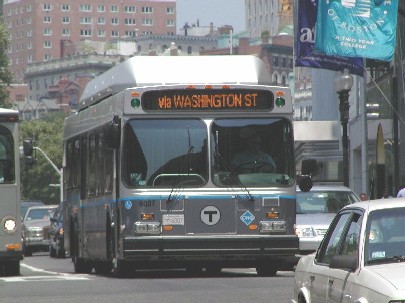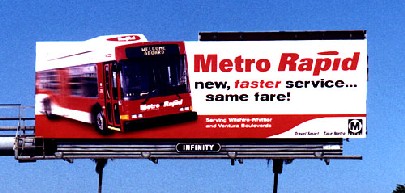Buses, Rapid Transit, and an article from the New York Times
Yesterday's New York Times alerted Dr. Transit that he missed an important article about buses as the paper had a handful of letters to the editor about bus services and marketing (2 out of the 3 were pretty good):
Judith Hauptman (New York, March 30, 2005) has two good ideas:
¶To reduce by half the time it takes people to board a bus, a serious cause of slowdown, make sure that people exit from the back only, not from the front, as nearly half of all passengers currently do.
¶Install not just one but two fare boxes at the front of the bus.
And Christian Allan (New York, March 30, 2005) discusses the Metrocard:
While it was a fantastic device when it was introduced, the "dip" to pay on a bus slows boarding to a crawl.
The M.T.A. should follow Transport for London, with its Oyster Card, or the Citybus system from Hong Kong, with its Octopus card.
These cards don't need to be swiped; they are simply placed on a reader, greatly speeding up boarding.
Additionally, they work through wallets and purses, meaning that riders don't even have to take the cards out.
___________________
These letters were in response to the article "Trying to Get Buses to Crawl a Little Faster: New York looks to Los Angeles for Ways to Move Speedometers Up a Notch" and a consideration of bus rapid transit for NYC as BRT has sped up buses in LA by 22 to 25%.
 Metro Rapid photos from The-Bus-Stops-Here website.
Metro Rapid photos from The-Bus-Stops-Here website.In my opinion, BRT probably works best in places that are less congested, and/or have a lot more roads*, like Los Angeles and in dedicated systems like Curitiba (and I could even see it work in the Dulles Corridor). An advantage to BRT, as the article points out is that it "costs $200,000 a mile, compared with $30 million to $50 million a mile to build light rail and $200 million to $300 million for a new subway, said Rex Gephart, the director of regional transit planning in Los Angeles." (*Note: LA has a lot more roads than DC or Manhattan.)
 (Photo from the MBTA website.) In Boston, the "Silver Line" BRT has been introduced, replacing a fixed rail system, and it hasn't always been well received. (Check out this BRT page on the Light Rail Now website for a more pro-rail slant, but with plenty of links to various BRT sources.)
(Photo from the MBTA website.) In Boston, the "Silver Line" BRT has been introduced, replacing a fixed rail system, and it hasn't always been well received. (Check out this BRT page on the Light Rail Now website for a more pro-rail slant, but with plenty of links to various BRT sources.)There are two ways of looking at BRT:
1. Actually speeding up service; versus
2. Marketing bus service better through branding and other service-enhancing based marketing activities.
Either leads to a renewed focus on bus transportation. The Silver Line, "Pike Ride" on Columbia Pike in Arlington, or Metro Rapid in LA provide a way for branding and promoting bus services in a positive and expansive fashion such as through the improved signage and route map information at the bus stops (not just on websites).

A branding and promotion campaign similar to that of Pike Ride has been proposed for H Street NE as part of the H Street Transportation Study, although I don't know what stage this plan is in at the moment. Pike Ride has increased service 45% over previous levels. Dr. Transit doesn't think that the issue with bus service on H Street is one of frequency, but of who uses the bus currently and the fact that higher-income people tend to ride subways (and those with the highest incomes--commuter rail) and that "they feel more comfortable riding with other people with comparable socio-economic status."
 (As I have written before, I think that WMATA's "Metro Open Doors" campaign is overly-focused on print as the primary advertising vehicle. "Outdoors advertising" is an area of great potential for Metro.)
(As I have written before, I think that WMATA's "Metro Open Doors" campaign is overly-focused on print as the primary advertising vehicle. "Outdoors advertising" is an area of great potential for Metro.)______________________
Note that this case study states that non-print media are a large portion of the "Metro Opens Doors" advertising campaign. Dr. Transit watches just a little television and only listens to radio in cars (and you can imagine how rarely Dr. Transit uses cars), but he figures he should have seen some non-print Metro ads at some point and yet, he can't recall any such instances. (You know the rule about advertising? You need to see an ad 7-9 times before you activate/change your behavior. But the ad needs to run 30 times so that any one individual sees it those requisite 7-9 times.)
Case Study: Metro Opens door
Source: www.imo.com
LM&O created the new slogan, Metro Opens Doors", while experimenting with different ways to get the Metro message across quickly and memorably. The slogan positions Metro not just as a fleet of buses and trains, but as a gateway to where one wants to go in the region--to work, to school, to shop, to travel or to play. The campaign launched with a :30 TV commercial during a NFL playoff game and will continue with a heavy schedule on D.C. market stations over the next few months. While TV serves as the cornerstone of the campaign, the message will appear widely in other media including radio, newspaper, theatre ads, and electronic billboards. Direct mail is also employed. Since the campaign was recently launched, results are not yet available. The campaign's success will be measured by an increase in ridership on Metrobus and Metrorail during off-peak hours
__________________________________
It would be hard to measure success by an increase in ridership because ridership is increasing anyway as the regional economy has finally recovered (for the most part) from 9/11, even though foreign tourism (which had the highest profits) is still down.
Dr. Transit has not yet read WMATA's Regional Bus Study so he hesitates, at this point, to write with his normal level of all-knowing authority.
Check out the DCist Transportation page.



0 Comments:
Post a Comment
<< Home